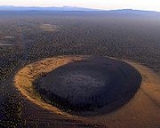
Hole-in-the-Ground
Encyclopedia
Hole-in-the-Ground is a large maar
(explosion crater) in the Fort Rock Basin
of Lake County
, central Oregon
, northeast of Crater Lake
, near Oregon Route 31.
It is about 1600 metre (0.994196378639691 mi) across, a little longer N-S than E-W. Its floor is about 150 metres (492.1 ft) below the surrounding ground level and has a rim that rises 35 to 65 m (114.8 to 213.3 ft) above, the highest point on the east side. The crater formed during the late Pleistocene
, between 13,500 and 18,000 years ago, at which time the Fort Rock Basin was a lake and the location was near the shore. Basaltic magma
intruding near the surface flashed ground water to steam, which blew out overlying rock and soil, along with some juvenile material. As material slid into the hole formed, it closed the vent and the process repeated, eventually forming the huge hole. Blocks as large as 8 metres (26 ft) in size were flung as far as 3.7 kilometres (2.3 mi) from the crater.
To the west of Hole-in-the-Ground is an even bigger maar, 1820 metres (1.1 mi), but older and more eroded, called Big Hole
.
Maar
A maar is a broad, low-relief volcanic crater that is caused by a phreatomagmatic eruption, an explosion caused by groundwater coming into contact with hot lava or magma. A maar characteristically fills with water to form a relatively shallow crater lake. The name comes from the local Moselle...
(explosion crater) in the Fort Rock Basin
Fort Rock Basin
Portions of this article include public domain text from the USFS .The Fort Rock-Christmas Lake Valley Basin is the basin of a former inland sea that existed in that region from Pliocene through late Pleistocene time....
of Lake County
Lake County, Oregon
Lake County is a county in the high desert south central region of the U.S. state of Oregon, so named for the many lakes found within its boundaries, including Lake Abert, Hart Lake Reservoir, and Goose Lake. While Lake is among Oregon's largest counties, it is sparsely populated with 7,895...
, central Oregon
Oregon
Oregon is a state in the Pacific Northwest region of the United States. It is located on the Pacific coast, with Washington to the north, California to the south, Nevada on the southeast and Idaho to the east. The Columbia and Snake rivers delineate much of Oregon's northern and eastern...
, northeast of Crater Lake
Crater Lake
Crater Lake is a caldera lake located in the south-central region of the U.S. state of Oregon. It is the main feature of Crater Lake National Park and famous for its deep blue color and water clarity. The lake partly fills a nearly deep caldera that was formed around 7,700 years agoby the...
, near Oregon Route 31.
It is about 1600 metre (0.994196378639691 mi) across, a little longer N-S than E-W. Its floor is about 150 metres (492.1 ft) below the surrounding ground level and has a rim that rises 35 to 65 m (114.8 to 213.3 ft) above, the highest point on the east side. The crater formed during the late Pleistocene
Pleistocene
The Pleistocene is the epoch from 2,588,000 to 11,700 years BP that spans the world's recent period of repeated glaciations. The name pleistocene is derived from the Greek and ....
, between 13,500 and 18,000 years ago, at which time the Fort Rock Basin was a lake and the location was near the shore. Basaltic magma
Magma
Magma is a mixture of molten rock, volatiles and solids that is found beneath the surface of the Earth, and is expected to exist on other terrestrial planets. Besides molten rock, magma may also contain suspended crystals and dissolved gas and sometimes also gas bubbles. Magma often collects in...
intruding near the surface flashed ground water to steam, which blew out overlying rock and soil, along with some juvenile material. As material slid into the hole formed, it closed the vent and the process repeated, eventually forming the huge hole. Blocks as large as 8 metres (26 ft) in size were flung as far as 3.7 kilometres (2.3 mi) from the crater.
To the west of Hole-in-the-Ground is an even bigger maar, 1820 metres (1.1 mi), but older and more eroded, called Big Hole
Big Hole (Oregon)
Big Hole is a large maar in the Fort Rock Basin of Lake County, central Oregon, northeast of Crater Lake, near Oregon Route 31. It is approximately 6000 ft across and deep....
.

